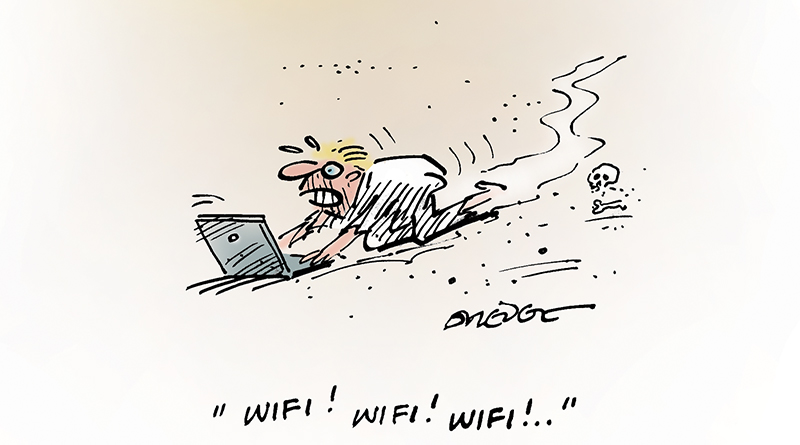How to Talk Wi-Fi with Non-Tech People
By Leslie Ellis
By now it’s pretty clear that Wi-Fi is a basic digital need, sometimes laughingly lumped into the lowest layer of Maslow’s Hierarchy of Human Needs — which includes things like breathing, food, water, and sleep. Consumer studies repeatedly verify this, with results that inspire clever headlines, like “Broadband, Wi-Fi More Important Than Clean Underwear,” penned by the ever-witty Todd Spangler, a long-time tech writer for Multichannel News, who now writes for Variety.
His point was that people who live in apartments rank Wi-Fi connectivity as more important than an in-unit washer-dryer, but still, it’s not every day that technology and underpants share space in a news headline.
That’s why this, my first installment in this new column forBroadband Library, shines the light on some of the more difficult concepts to somehow convey to the nation’s millions of broadband partakers. If you’ve ever tried to talk someone through the difference between speed and throughput, you can relate.
Let’s start with a bit of history. In the early days of Wi-Fi as the primary wireless spigot for Internet connectivity, customer care calls tended to bunch up around two questions: What’s my SSID, and what’s my password? (Aside: I keep a list of funny Wi-Fi SSIDs. My favorite so far: “Tell my Wi-Fi love her.”)
These days, the people in care face much more complex consumer frustrations, like “why can’t I get signal in the (insert name of the farthest corner of a home)” and “why doesn’t the nth tablet get Wi-Fi as good as the rest of my connected devices?”
This is only going to get more complicated, as we collectively connect more and more things, beyond PCs, laptops, tablets and smartphones, over Wi-Fi. Fun fact: According to data from a recent RDK (reference design kit) gathering, only one in every 30 customers connects to the Internet over a wire (Ethernet). The rest rely on Wi-Fi.
For these reasons, it seems like a good time to figure out how to talk to consumers about their Wi-Fi lives. Here’s my short list:
Wi-Fi and the Internet are two separate things. In the grand scheme of things, and in the pursuit of “it should just work,” this shouldn’t matter. Except it does. Why? Because lots (and lots) of people tend to equate their Wi-Fi connection with their Internet connection. It follows that most people tend to run Internet speed tests not because they’re actually interested in speeds, but because something isn’t working right. A Netflix stream is buffering; a download seems sluggish. This is exacerbated by the fact that many consumers buy third-party wireless routers, which are difficult, if not impossible, for operators to monitor and adjust.
Everything wireless needs a wire, at some point.The stuff in your digital garden connects over Wi-Fi to one of two things: An access point (AP), or an operator-provided gateway. It’s helpful in these discussions to bust out a napkin and a pen, then draw a connectivity map. The gadget connects to the AP/gateway, which flings data up the HFC (hybrid fiber/coax) plant to the CMTS (cable modem termination system), which connects to the “big Internet.”
If you value your Wi-Fi connection, give some thought to where your Wi-Fi spigot resides.Even here in the geek-o-sphere, the Wi-Fi router sits on a shelf in the garage, which is behind a brick fireplace. Parallel field tech stories abound about service calls regarding poor Wi-Fi connections: The truck gets rolled. The tech goes inside, only to find the router situated near the floor, accidentally covered up by a jacket, or a backpack, or a couch cushion. If Wi-Fi is that important, put the dang router near the center of the living space. (Harumph!)
Speed is different than coverage.We live in a nation beset with “McMansions,” sometimes spanning double-digit thousands of square feet. At the other side of the spectrum, older homes, constructed of thick plaster walls (like much of Europe), also suffer from occluded connectivity. In these cases, some kind of mesh/extender is in order. It’s a tricky conversation, because extenders are built for wall-to-wall coverage — but when you run a speed test on them, they’ll invariably show a somewhat slower connection than devices nearest the Wi-Fi spigot. The good news is, extenders will generally enable everything people do with Wi-Fi, from streaming video to Facetime to simple email and social network posts.
That’s the start of what is probably a much longer conversation, about how to be the superlative provider of Wi-Fi connectivity. We need to work together on this. That means you! Comment/share with reckless abandon please. Over’n’out for now.
 Leslie Ellis,
Leslie Ellis,
President, Ellis Edits Inc.
leslie@ellisedits.com
Leslie Ellis is a tech writer focused on explaining complex engineering stuff for people who have less of a natural interest than engineers. She’s perhaps best known (until now!) for her long-running weekly column in Multichannel Newscalled “Translation Please.” She’s also written two broadband dictionaries, one field guide to broadband, and is co-author of “Planet Broadband” with Roger Brown and Stewart Schley. She’s served as Senior Technology Advisor to CTAM since 2001, and is a behind-the-scenes tech translator for domestic and global service providers, networks, and suppliers.
Cartoonstock




